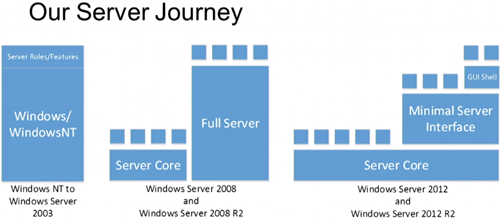News
Windows Server vNext To Be Optimized for Cloud
- By Kurt Mackie
- February 06, 2015
Microsoft will be adding "deep refactoring" architectural changes to the next version of Windows Server, code-named "vNext," that are aimed at cloud scenarios.
In a Day 2 Microsoft TechDays Online talk, Jeffrey Snover, a Microsoft Distinguished Engineer and the lead architect for the Windows Server Division, outlined the history of Windows Server and where it's going next. Snover is also the inventor of Windows PowerShell, a scripting language used to automate operations. His talk is currently available on demand via Microsoft's Channel 9 portal.
Snover's presentation was fairly high level and abstract, but it at least offered some hints about Microsoft's Windows Server direction. Microsoft recently announced plans to release its next Windows Server product sometime in 2016, along with its next System Center management suite, while Windows 10 is scheduled to arrive sometime this year. In the recent past, Microsoft had delivered its server and client Windows products in close proximity, but Snover offered a reason, perhaps, for the change in practice. He explained that the System Center team and the Windows Server team are now "a single organization," with common planning and scheduling. He said that the integration of the two formerly separate organizations isn't 100 percent, but it's better than it's been in the past. The team also takes advantage of joint development efforts with the Azure team, he added.
Snover pointed to the commonalities afforded by having a common Windows kernel now for Microsoft's Phone OS, Xbox, Windows client and Windows Server products. Solving energy consumption issues in Windows Phone also turns out to be important for Windows Server as well, he explained.
Evolution of Windows Server
Microsoft faced some issues in getting its Windows Server product, which was designed for enterprise use, up into the Internet cloud with the Azure product. The company ramped up those efforts with an Azure Red Dog team that was headed by Windows NT pioneer Dave Cutler, who came from DEC. Later on, Bill Laing, also coming from DEC, stepped in at Microsoft to build "a better server," resulting in the Datacenter Edition of Windows Server along with the Server Core. Snover, who had served as a consulting engineer at DEC with Laing, later joined Microsoft to address improving Windows Server management capabilities, contributing to Azure's datacenter abstraction layer and PowerShell's Desired State Configuration capabilities. Laing currently is corporate vice president for Windows Server and System Center Group Development.
The result was Server Core, which runs everything, with the ability to add a GUI (see figure), but Microsoft also aimed to shift its focus away from a server to a datacenter with its Windows Server developments.
 [Click on image for larger view.] Windows Sever evolution. (Source: Day 2 Microsoft TechDays talk.)
[Click on image for larger view.] Windows Sever evolution. (Source: Day 2 Microsoft TechDays talk.)
Snover said during the talk that the style of management in Windows Server had to change when making design decisions based on cloud principles. Microsoft needed to have a "datacenter abstraction layer" in place and it needed to have "software-defined everything" to make it work. Having things defined in software provides the benefit of more control. It also permits the use of cheaper hardware, Snover said.
Next Windows Server
The next Windows Server product will be deeply refactored for cloud scenarios. It will have just the components for that and nothing else, Snover explained. Next, on top of that, Microsoft plans to build a server that will be the same as the Windows Servers that organizations currently use. This server it will have two application profiles. One of the application profiles will target the existing APIs for Windows Server, while the other will target the subsets of the APIs that are cloud optimized, Snover explained. On top of the server, it will be possible to install a client, he added. This redesign is happening to better support automation, he explained.
Microsoft also is building two container capabilities in the next Windows Server. One of the containers will be focused on application compatibility. The other container will be optimized for the cloud, he said.
The next Windows Server is going to have "great Linux support," said Snover, who was wearing a "Microsoft Loves Linux" button. He claimed that Microsoft was the "largest contributor to the Linux kernel" a year and a half ago. Microsoft, in particular, has enhanced the performance of Linux on hypervisors, he explained.
"In the context of Azure, Microsoft makes more money if you have 10 installations of Linux than if you have two instances of Windows," Snover said.
Microsoft has been more open in terms of its datacenter abstraction layer, Snover said. Those efforts include standards-based management, open source WMI (OMI), Redfish Consortium support, OData standardization, an open source Desired State Configuration platform, Linux guest support and CoreCLR support on Linux. Microsoft even is supporting Pester, which is a PowerShell unit test framework effort that Microsoft is working on in collaboration with VMware.
Snover provided some advice for organizations in his talk. He said that organizations should just get off Windows Server 2003, which loses support in July. Organizations looking at new servers must have remote management and PowerShell automation capabilities, he added. Organizations should buy network interface cards (NICs) that support RDMA, which enables SMB 3.0. They should look to invest in Trusted Platform Modules on their servers going forward as Microsoft will require them in the near future. He also suggested that organizations should "reward the right people" (no more "click-next admins") and they should "join the dev-ops revolution."
Snover said people could get more details on Microsoft's plans by attending the company's Build and Ignite conferences, which are coming up in April and May, respectively.
About the Author
Kurt Mackie is senior news producer for 1105 Media's Converge360 group.